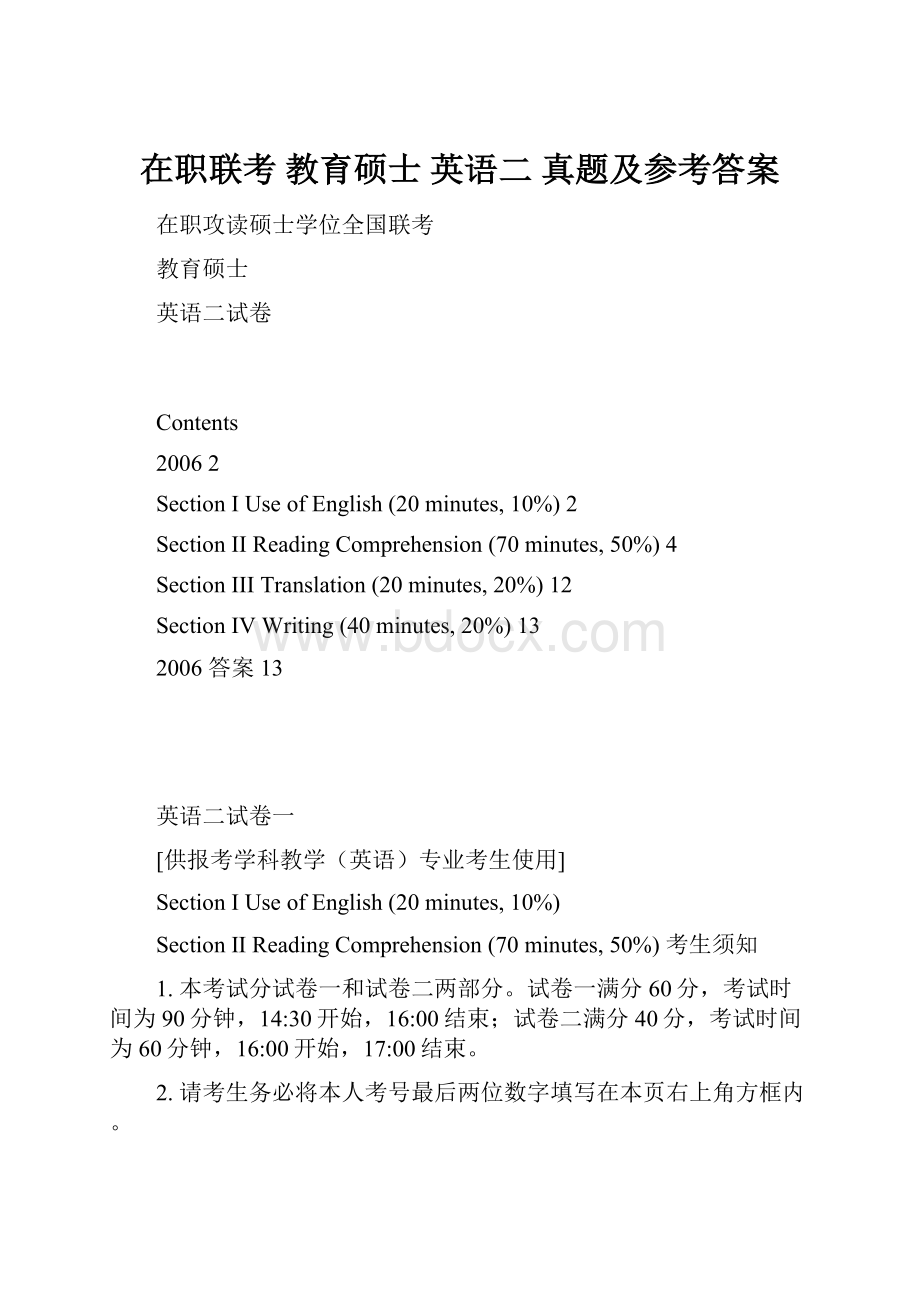在职联考 教育硕士 英语二 真题及参考答案.docx
《在职联考 教育硕士 英语二 真题及参考答案.docx》由会员分享,可在线阅读,更多相关《在职联考 教育硕士 英语二 真题及参考答案.docx(16页珍藏版)》请在冰豆网上搜索。

在职联考教育硕士英语二真题及参考答案
在职攻读硕士学位全国联考
教育硕士
英语二试卷
Contents
20062
SectionIUseofEnglish(20minutes,10%)2
SectionIIReadingComprehension(70minutes,50%)4
SectionIIITranslation(20minutes,20%)12
SectionIVWriting(40minutes,20%)13
2006答案13
英语二试卷一
[供报考学科教学(英语)专业考生使用]
SectionⅠUseofEnglish(20minutes,10%)
SectionⅡReadingComprehension(70minutes,50%)考生须知
1.本考试分试卷一和试卷二两部分。
试卷一满分60分,考试时间为90分钟,14:
30开始,16:
00结束;试卷二满分40分,考试时间为60分钟,16:
00开始,17:
00结束。
2.请考生务必将本人考号最后两位数字填写在本页右上角方框内。
3.本试卷一为A型试卷,其答案必须用2B铅笔填涂在A型答题卡上,做在其它类型答题卡或试卷上的无效。
答题前,请核对答题卡是否A型卡,若不是,请要求监考员予以更换。
4.在答题卡上正确的填涂方法为在答案对应的字母上划线,如[A][B][C][D]。
5.监考员宣布试卷一考试结束时,请立即停止答试卷一,将试卷一及其答题卡反扣在自己的桌面上,继续做试卷二。
监考员将到座位上收取试卷一及其答题卡。
6.监考员收卷过程中,考生须配合监考员验收,并请监考员在准考证上签字(作为考生交卷的凭据),否则,若发生答卷遗失,责任由考生自负。
英语二试卷二
[供报考学科教学(英语)专业考生使用]
SectionⅢTranslation(20minutes,20%)
SectionⅣWriting(40minutes,20%)
考生须知
1.试卷二满分40分,考试时间为60分钟,16:
00开始,17:
00结束。
2.请考生务必将本人考号最后两位数字填写在本页右上角方框内。
3.试卷二的答案必须用蓝色或黑色墨水笔写在试卷二答题卡指定区域内,未写在指定区域内的答案一律无效。
4.监考员宣布考试结束时,请立即停止答题,将试卷二和答题卡反扣在自己的桌面上,坐在原位,等待监考员收试卷二和答题卡。
待监考员全部收齐点清无误,宣布可以离场后,方可离开考场。
5.监考员收卷过程中,考生须配合监考员验收,并请监考员在准考证上签字(作为考生交卷的凭据),否则,若发生答卷遗失,责任由考生自负。
2006
SectionIUseofEnglish(20minutes,10%)
Readthefollowingtext.ChoosethebestwordforeachnumberedblankfromA,B,CorD.
Withitscommoninterestinlawbreakingbutitsextremelylargerangeofsubjectmatterandwidelyvaryingmethodsoftreatment,thecrimenovelcouldmakeareasonable1toberegardedasaseparatebranchofliterature.
Thedetectivestoryisprobablythemost2ofthecrimespecies.Itscreationisoftentherelaxationofuniversityteachers,3economists,scientistsorevenpoets.4mayoccurmorefrequentlyandmysteriouslythanmightbeexpectedinpolitesociety,5theworldinwhichtheyhappen,thevillage,seasideresort,collegeorstudio,isfamiliartous,ifnot6ourownexperience,at7inthenewspaperorthelivesoffriends.Thecharacters,8normallyrealizedsuperficially,areasrecognizablyhumanand9asourlessintimateassociates.Astorysetinamore10environment,Africanjungle,orAustralianbush,ancientChinaorgaslitLondon,11toourinterestingeographyorhistory,andmostdetectivestorywritersare12inprovidingreasonablytruebackground.The13,carefully-assembledplot,dislikedbythemodernintellectual14andcreatorsof‘significantnovels’,hasfound15inthemurdermystery,withasmallnumberofcluesandapparent16,allwithappropriatesolutionsandexplanationsattheend.17theguiltofescapismfromRealLifenagginggently,wesecretlytakegreatdelightinthe18ofevilbyavaguelysuperhumandetective,whoseesthroughanddispersesthe19ofsuspicionwhichstayedsounjustlyoverthe20.
01.
[A]plea
[B]appeal
[C]claim
[D]assertion
02.
[A]acceptable
[B]respectable
[C]debatable
[D]vulnerable
03.
[A]literary
[B]curious
[C]sensible
[D]observant
04.
[A]Schemes
[B]Assassinations
[C]Mysteries
[D]Misfortunes
05.
[A]and
[B]but
[C]as
[D]for
06.
[A]by
[B]in
[C]from
[D]with
07.
[A]last
[B]best
[C]most
[D]least
08.
[A]if
[B]when
[C]most
[D]least
09.
[A]consistent
[B]insistent
[C]persistent
[D]competent
10.
[A]strange
[B]remote
[C]primitive
[D]mysterious
11.
[A]attracts
[B]accords
[C]appeals
[D]applies
12.
[A]conscious
[B]ambitious
[C]industrious
[D]conscientious
13.
[A]elaborate
[B]accurate
[C]considerate
[D]deliberate
14.
[A]authors
[B]critics
[C]novelists
[D]spectators
15.
[A]flaw
[B]trouble
[C]refuge
[D]evidence
16.
[A]contradictions
[B]probabilities
[C]implications
[D]impossibilities
17.
[A]With
[B]For
[C]Despite
[D]Without
18.
[A]unveiling
[B]unmasking
[C]unwitting
[D]unpacking
19.
[A]fog
[B]mist
[C]shade
[D]cloud
20.
[A]victim
[B]suspect
[C]innocent
[D]accused
SectionIIReadingComprehension(70minutes,50%)
PartA
ReadthefollowingtextandanswerthequestionsbychoosingA,B,CorD.
Virtueisnotsomuchamatteroflearningspecificrulesorprinciplesasitisoneofdevelopingspecialskillsofexercisingone'scapacityforrightaction.Since"virtue"canmeanboth"moralgoodness"and"successfulorexcellentaction,"commentregardingtheteachingofvirtuemustapplytobothsensesorusesoftheterm,narroworbroad.Botharemattersofhumanactionoractivityand,assuch,aretaughtperformatively.
Thatvirtueistaughtandlearnedperformativelyhassomethingtodowiththenormativequalityofhumanactionoractivity.Normsarewaysofdoingsomething,gettingsomethingdone,whicharetaughtbydoingandshowinghowtodo.Beingnormative,however,humanactionscangowrong.AsStanleyCavellwrote:
"Themostcharacteristicfactsaboutactionsisthattheycanbeperformedincorrectly.Thisisnotamoralassertion,thoughitpointsthemoralofintelligentactivity.Theseareactionswhichweperform,andoursuccessfulperformanceofthemdependsuponouradoptingandfollowingthewaysinwhichtheactioninquestionisdoneanduponwhatisnormativeforit."Thus,intalkingaboutvirtue,wearetalkingaboutnormativematters,matterstaughtandlearnedintermsofunsuccessfulhumanaction.Assuch,wearespeakingaboutthecultivationofhumanskillsandpractices,humanwaysofactinginthisworld.
Whethervirtueisnarrowlyorbroadlyunderstood,theteachingofvirtueistheteachingofaskillwithinapracticeofformoflife,thetrainingofacapacity,notthememorizationofrulesorguidelines.Virtueisembodiedinaction;accordingly,ourknowledgeofvirtueisakindofperformativeknowledge----bothknowledgeacquiredthroughactionandknowledgeexpressedorrevealedinaction.Ourknowledgeofvirtueisnot,then,amatterofprepositionalknowledge,butratheramatterofperformativeknowledge.Thishelpsaccountforourrelativeinabilitytodefinewhatvirtueiswithanyassurance.Knowingwhatvirtueis,isnotthesameasknowingwhatsomekindofobjectis,becausevirtueisnotanobject.AndsincesomuchofWesternthoughtusesourknowledgeofobjectsastheparadigmofknowledge,anykindofknowledgethatdoesnotfitthemodelisapttoseemnotquiteorfullyknowledgeatall.Hence,aninabilitytoarticulatethemeaningofvirtueisnotasignofthelackofknowledgeofvirtue.Instead,itisapartofthegrammarofvirtue:
itshowswhatkindofthingvirtueis.
21.Thebroaddefinitionofvirtuediffersfromthenarrowoneinits
[A]dealingwithculturalnorms.
[B]rulingoutphysicalactivities.
[C]comprisingtheskillfulteaching.
[D]involvingmorethanmoralhonesty.
22.Theauthorwoulddepicttheviewthatsomehumanactionsaremorallynon-normativeas
[A]logicallypersuasive.
[B]profoundlymistaken.
[C]reasonableandpractical.
[D]ambiguousandmisleading.
23.Whichofthefollowingstatementsaboutnormswouldtheauthorsupport?
[A]Mostofthemaretheresultofpersistentteaching.
[B]Theyarederivedfromspecificrulesforbehavior.
[C]Theyareessentialtotheacquisitionofvirtue.
[D]Manyofthemaresoundprinciplesofaction.
24.Theauthorarguesthatteachersofvirtuestriveprimarilytopasson
[A]practicalcapabilities.
[B]culturalconventions.
[C]favorableexperiences.
[D]traditionalprinciples.
25.Itwouldserveasanexampleforthe"prepositionalknowledge"(Par.3)to
[A]experimentonatrialanderrorbasis.
[B]learndiversephilosophicaldefinitions.
[C]practicevirtuebyimitatingmoralactions.
[D]advanceargumentswithoutenoughevidence.
26.Thetextischieflyaimedat
[A]revealingdiverseattitudestowardvirtue.
[B]insistingonthevalueofcapacitytraining.
[C]arguingfortheessenceofvirtueinstruction.
[D]providingapproachestotheteachingofvirtue.
PartB
Youaregoingtoreadanextractaboutsignlanguage.Sixparagraphshavebeenremovedfromtheextract.ChoosefromParagraphsA-Gtheonewhichfitseachgap(27-32).Thereisoneextraparagraphwhichyoudonotneedtouse.
SignLanguage
SincemostdeafchildrenhaveheatingparentsandthusdonotlearnASL(AmericanSignLanguage)athome,theynormallylearnitfromtheotherdeafchildrenwhentheygettoschool.However,theminorityofdeafchildrenwithdeafparentslearnASLunderconditionssimilartothoseofheatingchildrenlearningspokenlanguage.
27
Asmentionedearlier,deafchildrenengageinmakingsoftsoundsasmuchasdohearingchildren.However,ithasbeenclaimedthatbabblingfallsoffindeafchildrenaftersixmonths,presumablyduetothelackofauditoryfeedback.Ithasalsobeenclaimedthatmirrorshungoverthecribsofdeafbabiesprolongandincreasetheirvocalization.
28
Thefirstword(sign)generallyappearssoonerinASLthaninspeakingchildren.Thefirstsignhasbeenreportedasbeingat5or6months,‘comparedwith10monthsinnormalchildren.Two-signutteranceshavebeenreportedinchildrenasyoungaseightmonths.Tworeasonsforsuchearlyacquisitionhavebeengiven.Oneisthenatureofmanysigns.
29
Thefirstsignsappeartobeofthesametypesthathavebeenreportedforacquisitionofvocallanguage----forexample,signsforthingsthatmoveorthatcanbehandledbythechild.
30
Childrensometimeswillmakethesigninthewrongorientation.Forexample,thesignmeaning"shoes"ismadebybringingthetwofiststogether,makingcontactatthesideofthehands.Onechildbroughtthefiststogethersothattheknucklesmadecontactinstead.Ortheymightbringthehand,palmdownwardtothebottomofthechinandwi